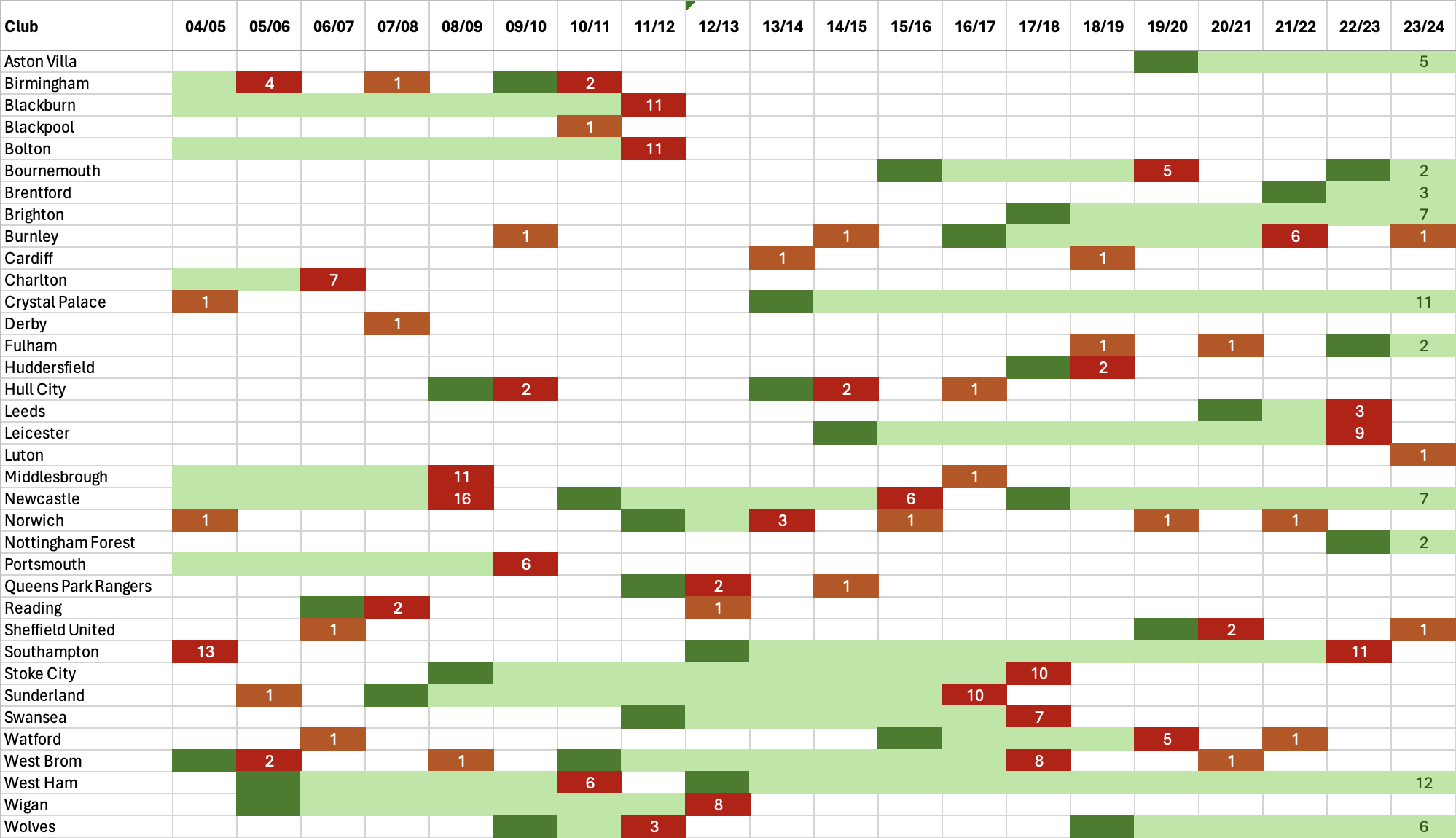
Every year clubs in the EFL Championship compete tooth-and-nail for the top three promotion positions injecting them into the English Premier League. Those that dare to challenge the two league leaders do so knowing they will enter a play-offs scenario to obtain that third lucrative promotion place. Getting promoted is one thing, staying in the Premier League is another matter entirely.
Looking forward to the 2024/2025 season:
- Leicester City have a 35% chance of relegation as League Winners.
- Ipswich Town have a 55% chance of relegation as runners up.
- Southampton have a 55% chance of relegation as play-off winners.
A glance a the financial landscape
The Premier League figures for the 2022-23 season showed that broadcast revenue totalling more than £2.7 billion ($2.9bn) was distributed among the 20 clubs in the Premier League. The base line of roughly £88.6 million ($111m) paid out to each club, regardless of position. Finally layered on is the merit amount which saw last place takeaway £103m ($129m) for the season. We can clearly see how promotion propells the club into revenue streams that allow them to invest and do so in way that helps them remain in the Premier League.
As articulated by The Athletic "The Championship has become the division of financial strain and distress. The majority of its 24 clubs are now conditioned to accept loss-making. Money spent on wages consistently — and comfortably — exceeds the collective revenue each year." now layer on the mouthwatering fortunes of the Premier League even just a single season is all it takes to relief the agony. The prospect of moving from the Championship to the Premier League can be the difference of breaking this vicious cycle, or succumb to financial collapse.
Parachute payments were introduced by the Premier League in the 2006/07 season as a method of limiting the financial damage a relegated club may endure when dropping down to the Championship. The Premier League will pay the parachute payments as instalments over a period of three years. The first payment is 55% of the broadcasting revenue which every club receives after the equal split. Additionally, the second season is 45% and then 30% in the second and third season after relegation respectively.
This writeup is not focused on the finance aspect of the topic, I simply wanted to include it because it adds rich context to the following analysis.
Let's take a look at the historical data

The past two decades of promotion tells an impelling story of opportunity, success, and disappointment.
Using public Premier League promotion and religation data from the past 20 years, highlights just how difficult it is for clubs to promote and remain in the top flight.
Time to crunch some numbers

44.4% of promoted clubs are relegated the very next season.
69.2% of promoted clubs are relegated by their second season.
75.0% of promoted clubs are relegated by their third season.
Ouch! What this tells us is that newly promoted clubs face enormous challenges in adapting to the league's relentless and unforgiving competitive environment. This pressure to survive leads to unsustainable spending and a lack of squad chemistry.
Further, the stressful environment impacts both players and management and has lead to poor early-season results, jeopardizing their ability to collect precious points and causing frequent managerial changes, which are incredibly disruptive to established and long-term strategic planning.
Does sacking the manager actually help?
Sacking a manager as a strategy to avoid relegation can yield mixed results, with statistical analysis indicating a slight improvement in survival chances. Across various instances in the past two decades, teams that changed managers mid-season to stave off relegation demonstrated a modest increase in the likelihood of remaining in the Premier League, with an estimated probability difference of around 10-15% compared to those that retained their initial manager.
However, the impact of managerial changes is contingent upon several factors such as the quality of replacement, squad dynamics, and the timing of the change, suggesting that while it can provide a boost, success is not guaranteed.
What separates the clubs that remain and those that drop?
Clubs like Crystal Palace, West Ham United, Newcastle United, and Southampton have achieved sustained success in the Premier League through strong financial management, effective leadership, and strategic investments. These clubs prioritize sustainable financial practices, avoiding excessive debt and ensuring steady investments in quality players and infrastructure. Notable examples include West Ham and Newcastle's significant player acquisitions, which have enhanced their competitiveness at the top level. Furthermore, maintaining managerial stability with experienced leaders such as Roy Hodgson and David Moyes has provided these clubs with tactical expertise and continuity, fostering a cohesive playing philosophy and consistent performance.
Investment in youth development and modern facilities has also been pivotal. These clubs have robust academy systems that produce homegrown talent, reducing reliance on expensive transfers and ensuring a steady stream of skilled players. Southampton, for instance, has a strong reputation for developing stars like Gareth Bale and James Ward-Prowse. Additionally, state-of-the-art training facilities and stadium improvements attract and retain talent, enhance matchday revenue, and improve overall club performance. The integration of young players into the first club provides fresh motivation and significant contributions to the club’s success.
Norwich City and West Bromwich Albion are the most frequently promoted clubs, each achieving promotion five times. Burnley has been promoted three times and notably managed to remain in the Premier League for six consecutive years during one of their stints, highlighting their ability to achieve some stability amidst the competitive environment.

There has been a gradual decline in the points required to avoid relegation, represented by the dashed trend line. In the 2003/04 season, approximately 35 points were needed, but this has gradually dropped, hitting as low as around 28 points in the 2022/23 season. This decline indicates that the lower half of the Premier League has become more competitive, with fewer points separating the clubs, making it slightly easier for clubs to avoid relegation with fewer points.
The decreasing trend in the points needed to avoid relegation can be seen as both an opportunity and a challenge for newly promoted clubs. On one hand, the lower threshold means that newly promoted clubs may find it slightly easier to stay up if they can secure a reasonable number of points. However, the intense variability and occasional spikes in the required points underscore the unpredictability and competitive nature of the Premier League. Newly promoted clubs must therefore prepare thoroughly to handle both the best and worst-case scenarios, emphasizing the need for strategic squad strengthening and adaptability to secure their Premier League status.
In conclusion
In essence, promotion to the Premier League is a high-stakes gamble that can either usher in a transformative financial windfall or a swift and brutal return to the Championship. With 44.4% of newly promoted clubs facing relegation in their first season and a daunting 75% by the third, the path to stability is fraught with challenges.
The financial disparities between the leagues, the immense pressure to perform, and the critical importance of strategic management all underscore the delicate balance clubs must strike to thrive. Clubs that master the art of blending astute financial management, strong leadership, and tactical adaptability, like Crystal Palace and Newcastle United, are the ones that defy the odds, ensuring their place among football’s elite. The journey from the Championship to the Premier League is not just a battle for promotion but a relentless fight for survival.
•